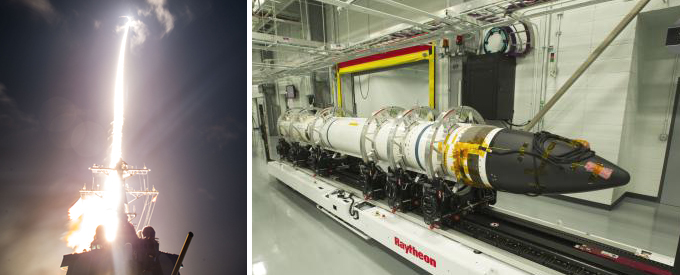2020-02-02
Raytheon Bags US$1 Billion Missile Contract
The U.S. Department of Defense recently awarded US$ 1 billion worth Standard Missile-3 Block IIA contract to Raytheon Company. The next-generation SM-3 Block IIA interceptor features a larger rocket motor and enhanced kinetic warhead to defend a wider area.
The current contract is sole-source, cost-plus-incentive-fee, and cost-plus-fixed-fee modification, under a previously awarded contract. The purpose of this modification is reportedly to:
1. Definitise the previously awarded SM-3 Block IIA fiscal 2018 undefinitised contract action (UCA) under contract line item numbers (CLINs) 0014 and 0015 for U.S. and Foreign Military Sales (FMS) All-Up Rounds (AUR)s production with a total value of US$650,638,397;
2. Award the fiscal 2019 SM-3 Block IIA U.S. and FMS AURs under CLINs 0016 and 0017 for a total value of US$590,322,857; and
3. Establish option CLINs 0018 and 0019 for the fiscal 2020 SM-3 Block IIA U.S. and FMS AUR production for a total value of US$435,978,438.
Under this modification, the contractor will provide the management, material and services associated with the procurement, manufacture and assembly for a total of 62 SM-3 Block IIA AURs, inclusive of all options. This modification increases the total cumulative face value of the contract by US$1,022,573,692 from US$1,467,045,869 to US$2,489,619,561. The Missile Defense Agency, Dahlgren, Virginia, is contracting the activity.
SM-3 missiles have three-stage missiles, sharing the first two stages of the SM-2 Block IV along with a third stage solid-propellant rocket to increase velocity at atmospheric exit. The kill vehicle for the SM-3 is derived from the Lightweight Exo-Atmospheric Projectile or LEAP. It combines a kinetic warhead with a longwave infrared seeker for target discrimination as well as divert and attitude control thruster to manoeuvre the kill vehicle in response to the information collected by the seeker.
Beating Ballistic Missiles
The SM-3 interceptor is a defensive weapon the U.S. Navy uses to destroy short- to intermediate-range ballistic missiles. The interceptor uses sheer force, rather than an explosive warhead, to destroy its target. Its “kill vehicle” hits threats with the force of a 10-tonne truck traveling 600 mph. This technique, referred to as “hit-to-kill,” has been likened to intercepting a bullet with another bullet.
The SM-3 interceptor is referred to as a critical piece of the Phased Adaptive Approach for missile defence in Europe. The interceptor is being carried by U.S. Navy ships deployed off Europe’s coast and is now operational at a land-based site in Romania, enhancing Europe’s protection. When the next land-based SM-3 interceptor site becomes operational in Poland, all of Europe will reportedly be defended from ballistic missile attacks.
The flexibility of the SM-3 interceptor to be both land- and sea-based offers countries that do not have ballistic missile defence-enabled navies to take advantage of the capacity to protect large areas of land. This is often referred to as regional defence. The SM-3 missile can cover larger areas with fewer installations, when compared to other "lower tier" missile defence solutions.
The programme has nearly 30 successful space intercepts, and more than 250 interceptors have been delivered to U.S. and Japanese navies.
Whether on land or at sea, the SM-3 interceptor continues to excel in testing. In 2014, the Block IB variant was successfully launched for the first time from an Aegis Ashore testing site in Hawaii. Later in the year, the missile destroyed a short-range ballistic missile target during a highly complex integrated air and missile defence exercise in the Pacific Ocean. The interceptor participated in an international, NATO-led exercise in 2017 that simulated real-life threat scenarios. Strong cooperation between allied nations and industry has helped ensure its readiness to defeat complex threats around the world.
The SM-3 Block IB interceptor has an enhanced two-colour infrared seeker and upgraded steering and propulsion capability that uses short bursts of precision propulsion to direct the missile toward incoming targets. It became operational in 2014, deploying for the first time on U.S. Navy ships worldwide.
Next Generation Interceptor
In August 2019, the U.S. State Department approved the Government of Japan’s request to purchase up to 73 SM-3 Block IIA missiles in a deal valued at around US$3.295bn. The SM-3 Block IIA interceptor is developed under a joint effort between Raytheon and Japan for protection against ballistic missile threats. As part of the deal, Japan will also receive MK 29 canisters with packing, handling, storage, and transportation (PHS&T) kits, as well as special assignment airlift mission (SAAM) flights. Additionally, the possible sale will include technical assistance, engineering and logistical support services.
It has two distinct new features: larger rocket motors (21-inch diameter) that will allow it to defend broader areas from ballistic missile threats and a larger kinetic warhead. This expands the range of the system and the number of targets it can engage. The interceptor’s kinetic warhead has been enhanced, improving the search, discrimination, acquisition, and tracking functions, to address advanced and emerging threats. The Block IIA also incorporates a more sensitive sensor seeker; more divert capability, and longer operating time for its upgraded kill vehicle.
The SM-3 IIA missile intercepted an advanced ballistic missile threat in its first live target test in early 2017. The intercept was preceded by two successful non-target flight tests. It will be deployed ashore in Poland to complete Phase 3 of the European Phased Adaptive Approach.
Reference Text/Photo:www.raytheon.com


No Comments